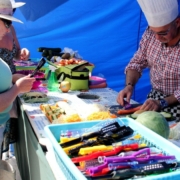Lanzarote is covered in rocks, and over 2,000 years of human habitation have left those rocks arranged in all sorts of patterns.
Drive around the outskirts of Arrecife, for example – down the hill from San Bartolomé or in from Güime – And you´ll see hundreds of piles of stones dotted all over the otherwise featureless countryside. At first it´s difficult to understand what they are, but all becomes clear the minute you look out of your plane window when departing from the airport, when it can be clearly seen how they mark out straight lines and the boundaries of plots of land, while also allowing the land to be cleared of stones so that farmers could work it.
A cairn, or pile of stones, is called a mojón in Spanish, and is one of the earliest markers that can be found. In areas such as Zonzamas or the plain leading down to Famara, you never quite know if a pile of stones was made twelve months or twelve centuries ago.
Walls are another ancient feature of the Lanzarote landscape. The aboriginal inhabitants of the island lived in semi-buried homes reinforced with dry-stone walls, and the dry-stone horseshoeshaped zocos that protect each grapevine are a unique emblem of the island.
Many of the older walls on the island are drystone-walls, made of nothing other than carefully arranged rocks. These walls are especially widespread across the water in Fuerteventura, where they criss-cross the island.
Sometimes, walled enclosures can be seen on higher hills of Lanzarote and the absence of gates or entries for livestock have led some to conjecture that they mark the ancient burial grounds of Maho natives. There is no evidence of this, however.
In the barrancos and valleys of the north of the island you’ll often see walled terraces, too. This involves turning a sloping hillside into a series of steps by building stone walls and piling them up with earth. This method of farming is little used today, but was vital in areas such as Los Valles, as it made the best possible use of rare rainfall.
Meanwhile, on the Camino Hoya Limpia leading down from Tías to Puerto del Carmen, you´ll see some of the most impressive walls on the island – huge structures that are mostly ruined nowadays. This zone was one of the most important farming areas on the island in times gone by, and the centre of the island’s tomato cultivation in the mid-20th century. However, it was necessary to clear millions of volcanic rocks from the land before it could be used. The result is huge drystone walls that are sometimes arranged into taros – enclosed areas where workers could get some shade from the scorching sunshine.
Other specialised structures made of stone include secaderos – areas covered in an even layer of smaller stones where fruit such as figs and grapes are laid out to dry in the sun. Meanwhile, goatherds would sometimes build a toril – a protected enclosure for newly born kids where the baby animal would not be attacked.
The stones and walls on the island have always had a close relationship with wildlife, as anyone who has walked alongside them knows. The sound of skittering lizards hiding among the rocks is a constant accompaniment in the countryside, while insects and birds are also found in this unique habitat.
If you’re considering a wall on your property, it’s worth hiring someone who can build the typical dry-stone structure, a typical aspect of Lanzarote and a haven for wildlife.











Leave a Reply
Want to join the discussion?Feel free to contribute!